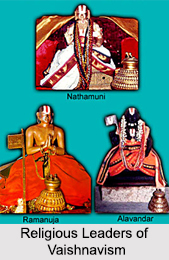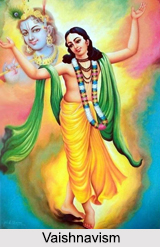 Development of Vaishnavism by Nathamuni, Yamunacharya and Ramanuja, the three eminent Acharyas of Vaishnavism saw a major upheaval in the belief and practice of Vaishnavism. They are regarded as the three main pontiffs of Vaishnavism. They were instrumental in preventing the gradual destruction of this belief system due to the increasing competition that it faced from the other major religious disciplines.
Development of Vaishnavism by Nathamuni, Yamunacharya and Ramanuja, the three eminent Acharyas of Vaishnavism saw a major upheaval in the belief and practice of Vaishnavism. They are regarded as the three main pontiffs of Vaishnavism. They were instrumental in preventing the gradual destruction of this belief system due to the increasing competition that it faced from the other major religious disciplines.
Development of Vaishnavism by Religious Leaders
The religion of Vaishnavism has been prevalent right from the Vedic period. Its teachings have been found scattered in the Vedas including the Upanishads, Ramayana and Mahabharata, the Indian Puranas, the Agamas and the hymns of the Alvars. During this long period of its growth, there was seen the increasing popularity of Buddhism, Jainism, Pashupatas and other forms of Shaivism and Shaktism. The chief opposition to Vaishnavism came from Shaivism, Buddhism and Jainism. Therefore, in order to uphold the teachings of Vaishnavism as against other religious creeds, there was the need to consolidate and systematise the Vaishnavite thoughts found in the various religious works. This task was fulfilled to a large extent by Ramanuja and his fore-runners, Nathamuni and Yamunacharya. Though all the three Acharyas are the exponents of Vaishnavism, major credit goes to Ramanuja in terms of the contribution made by written works and propagation of the religion through a large number of well qualified apostles.
Contributions of Nathamuni in Vaishnavism
Nathamuni, the first pontiff of Sri Vaishnavism, was born in AD 824. He wrote two works, namely "Nyayatattva" and "Yogarahasya". Both the works are an important philosophical treatise, since both Ramanuja and Vedanta Desika have referred to it. Nathamuni made a significant contribution to Vaishnavism by rediscovering the 4000 hymns of the Tamil Alvars. He re-arranged these into four parts and introduced its recitation by the Vaishnavas as part of the worship at temples. Following the teaching of Nammalvar, Nathamuni seems to have advocated the adoption of Prapatti or self-surrender as the means of salvation in place of the rigorous Bhakti Yoga.
 Contributions of Yamunacharya in Vaishnavism
Contributions of Yamunacharya in Vaishnavism
Yamunacharya was the grandson of Nathamuni. He was born in A.D. 916. Yamunacharya has written quite a few important works. These include the "Siddhitraya", "Agamapramanya", "Maha Purusa Nirnayam", "Gitartha Sangraha", "Stotra Ratnam" and "Chatusloki". Yamunacharya"s major contribution lies in the "Siddhitraya". It comprises three parts, each dealing with God, soul and knowledge respectively. The rest of his works have laid the foundation for the formulation of the important doctrines of Vaishnavism. These include the supremacy of Lord Vishnu as the ultimate Reality, the ontological status of Goddess Sri and the doctrine of Saranagati or self-surrender. The "Agamapramanya" vindicates the authoritativeness of the "Pancharatra Agamas" on the basis of which the Theology of Vaishnavism is developed.
Contributions of Ramanujacharya in Vaishnavism
The most significant contribution to the development and propagation of the Visistadvaita Philosophy and the Vaishnava Religion has been made by Ramanuja. Ramanuja was born in AD 1017, at a time when the Advaita Vedanta propounded by Sarhkara had made a great impact on the people. Some elemental teachings of Vaishnavism as expounded in the Vedas, Agamas and Puranas had to be established. These included the concepts of the exclusive worship of Vishnu as the direct means for Moksha and the restoration of individuality and reality of the souls and a positive state of blissful experience in a divine realm as the goal of human life. Ramanuja did a remarkable task of executing this task through his works and through his missionary institutions. Thus, Ramanuja stands as important milestone in the history of Vaishnavism.
Ramanuja has written 9 works of which there are 3 Gadyas. The rest are as follows;
1 `Sri Bhasya"
2. "Vedantadipa"
3. "Vedantasara"
4. "Vedarthasamgraha"
5. "Gitabhasya"
6. "Nitya-grantha"
In the "Sri Bhasya", which is the most outstanding philosophical work, Ramanuja presents the fundamental philosophical doctrines of Visistadvaita Vedanta on the basis of the interpretation of the Vedanta Sutras as provided by Bodhayana and other earlier Acharyas along with detailed explanations of the relevant Upanisadic and Smriti texts. The "Gitabhasya" is equally an important work in this, apart from establishing the supremacy of Vasudeva, the details of Bhakti Yoga, aided by Karma Yoga and Jnana Yoga, as the sadhana for Moksha is also brought out. The theory of avatara or incarnations of Vishnu is fully discussed on the basis of the Gita verses. The "Vedarthasamgraha" mainly expounds on the philosophy of the Upanishads. It contains the Visistadvaita views on Tattva (Reality), Hita (means) and Purusartha (supreme goal of life), besides the Supremacy of Vishnu and the doctrine of Nitya-vibhuti. The 3 Gadyas explain in detail the theological doctrine of Saranagati and the numerous attributes of God. The "Nityagrantha" sets out the daily observance of Vaishnavas as enjoined in the sacred texts along with the mode of worship of God.




















